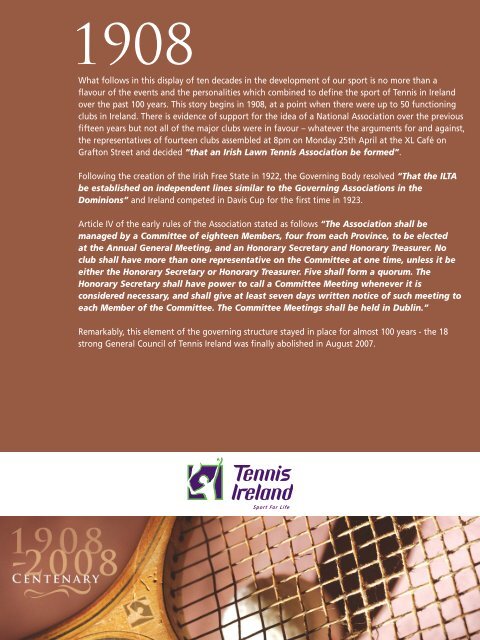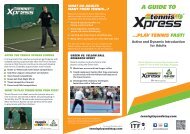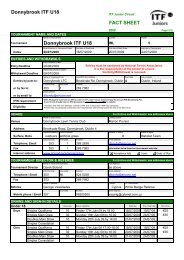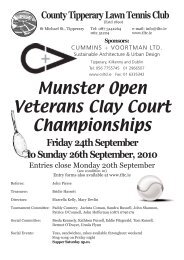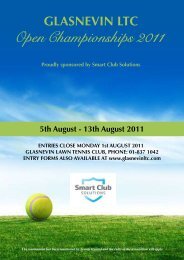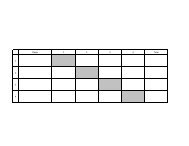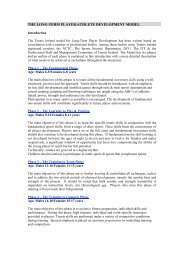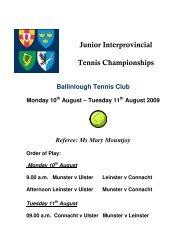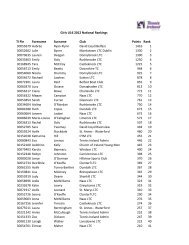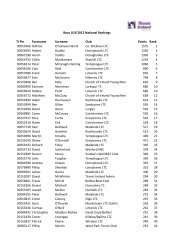History of Tennis Ireland 1908 - 2008
History of Tennis Ireland 1908 - 2008
History of Tennis Ireland 1908 - 2008
- No tags were found...
Create successful ePaper yourself
Turn your PDF publications into a flip-book with our unique Google optimized e-Paper software.
What follows in this display <strong>of</strong> ten decades in the development <strong>of</strong> our sport is no more than aflavour <strong>of</strong> the events and the personalities which combined to define the sport <strong>of</strong> <strong>Tennis</strong> in <strong>Ireland</strong>over the past 100 years. This story begins in <strong>1908</strong>, at a point when there were up to 50 functioningclubs in <strong>Ireland</strong>. There is evidence <strong>of</strong> support for the idea <strong>of</strong> a National Association over the previousfifteen years but not all <strong>of</strong> the major clubs were in favour – whatever the arguments for and against,the representatives <strong>of</strong> fourteen clubs assembled at 8pm on Monday 25th April at the XL Café onGrafton Street and decided “that an Irish Lawn <strong>Tennis</strong> Association be formed”.Following the creation <strong>of</strong> the Irish Free State in 1922, the Governing Body resolved “That the ILTAbe established on independent lines similar to the Governing Associations in theDominions” and <strong>Ireland</strong> competed in Davis Cup for the first time in 1923.Article IV <strong>of</strong> the early rules <strong>of</strong> the Association stated as follows “The Association shall bemanaged by a Committee <strong>of</strong> eighteen Members, four from each Province, to be electedat the Annual General Meeting, and an Honorary Secretary and Honorary Treasurer. Noclub shall have more than one representative on the Committee at one time, unless it beeither the Honorary Secretary or Honorary Treasurer. Five shall form a quorum. TheHonorary Secretary shall have power to call a Committee Meeting whenever it isconsidered necessary, and shall give at least seven days written notice <strong>of</strong> such meeting toeach Member <strong>of</strong> the Committee. The Committee Meetings shall be held in Dublin.”Remarkably, this element <strong>of</strong> the governing structure stayed in place for almost 100 years - the 18strong General Council <strong>of</strong> <strong>Tennis</strong> <strong>Ireland</strong> was finally abolished in August 2007.Sport For Life
J. C. Parke (1881 - 1946)Sport For LifeJames Cecil Parke, <strong>of</strong> Clones, Co Monaghan, easily provedto be one <strong>of</strong> the greatest international tennis players <strong>of</strong> histime while also excelling in rugby, golf, cricket, athleticsand chess. Born in 1881 in pre-independence <strong>Ireland</strong>, Parkeplayed for the British Isles in Davis Cup, which he securedunexpectedly in 1913 in Melbourne by beating NormanBrooke in the singles finals. Parke kept a detailed diary <strong>of</strong>the team’s trip to Melbourne which shows that while hewas extremely focussed on his game, he was also fullycapable <strong>of</strong> enjoying his time away from home and had anexcellent sense <strong>of</strong> humour.News reports and memoirs from Parke’s time show thathis style <strong>of</strong> tennis was exceptionally brilliant and his steelynerve struck fear in the heart <strong>of</strong> his every opponent.A New York Times article dated June 1920 described thespectators at a match in which Parke beat then Americansingles champion William Johnston as being “…agog withexcitement throughout what was regarded as one <strong>of</strong> thegreatest matches ever played on the historic Wimbledoncourt.”Parke’s remarkable achievements made him an inspirationto sportsmen and women the world over and a significantsource <strong>of</strong> pride to the Irish sporting community – withoutdoubt his Mens doubles silver medal at the <strong>1908</strong> LondonOlympics considerably enhanced his iconic status.
2004 recipient <strong>of</strong> the Maunsell Award John Doran withPatrick Manley, Eagle Star and James Foley, <strong>Tennis</strong> <strong>Ireland</strong> PresidentHarry Maunsell was an accomplished player in his ownright and played for his club in Glenageary throughoutmuch <strong>of</strong> the early twentieth century, having joined in 1903.However, his greatest achievements in Irish tennis were inthe area <strong>of</strong> expanding the scope <strong>of</strong> the game through hisrole as Honorary Secretary <strong>of</strong> the ILTA from 1920 to 1948.While promoting Irish tennis in the international sphere,Maunsell pursued a local agenda <strong>of</strong> increasing the appeal<strong>of</strong> tennis to a wider audience and encouraging theparticipation <strong>of</strong> children in the sport.Records show that Maunsell was a progressive, modestand dedicated administrator. His legacy lives on in theprestigious Maunsell Trophies, awarded annually by <strong>Tennis</strong><strong>Ireland</strong> to the senior male and female players deemed tohave had the greatest on-court achievements in that year.Sport For Life
Kalle Schroeder (Sweden) & George McVeagh - Davis Cup 1936.George McVeagh, one <strong>of</strong> the greatest Irish tennis players<strong>of</strong> the early twentieth century, possessed an almost superhumanability to master any sport to which he turned hishand. He held the unprecedented, and to this day unsurpassed,honour <strong>of</strong> representing <strong>Ireland</strong> internationally intennis, squash, cricket and hockey. Despite an allegedlypoor serve and having taken up tennis in his mid-twenties,McVeagh’s unorthodox style <strong>of</strong> play was obviously supplementedby his excellent ball skills and limitless energy andstamina in the game. He went on to represent <strong>Ireland</strong> inDavis Cup over twelve ties and once beat American goldenboy Bill Tilden in two out <strong>of</strong> three practice matches inLondon, stunning and infuriating the pr<strong>of</strong>essional.McVeagh’s prowess on the court continued far beyond his20s – in 1950, at the age <strong>of</strong> 43, he beat a young GerryFitzpatrick at the Fitzwilliam Championships to take thetitle for the second time, fifteen years after his first victory.In later years, McVeagh remained involved and active intennis and held the Presidency <strong>of</strong> Fitzwilliam LTC in thelate 1950s.Sport For Life
B. W. Rooke (S. A.) & Cyril Kemp (<strong>Ireland</strong>) - Mens Irish Open 1950One <strong>of</strong> the most accomplished tennis players ever to gracethe Irish sporting scene, Cyril Kemp reigned steadily asnumber one player in the country throughout the 1940sand never wandered too far from the top spot in thepreceding or following five years. His greatest coupcertainly entailed his sound victory over Tom Brown <strong>of</strong>the USA, then one <strong>of</strong> the top ranked players in the world,at the 1947 Irish Open Championships at Fitzwilliam. Brownhad reached the final at Wimbledon the week prior tohis Irish appearance. Kemp stunned his opponent andspectators alike by knocking the American out <strong>of</strong> thetournament and apparently shocked then President <strong>of</strong>Fitzwilliam, Willie Sandys, so that “his face was like thedeath <strong>of</strong> night”, according to Kemp’s contemporary JoeHackett.Cyril Kemp was well known for his remarkablesportsmanship and generosity, and earned great respectfrom his peers by maintaining his superior game oversuch a long period while working full time and fitting inpractice and indeed competition after working hours andduring holidays.Sport For Life
Beginning at the age <strong>of</strong> 6 on the family court with hisolder brother, Joe Hackett has had one <strong>of</strong> the mostimpressive tennis careers in Irish history and continued toplay regularly and well into his late seventies. Hackett, whohas described tennis as “a great passport to life”, showedthe first real sign <strong>of</strong> great promise when he reached thefinal <strong>of</strong> the Irish Championships at the age <strong>of</strong> 16. His gameadvanced rapidly and he was repeatedly selected for thesingles championships at Wimbledon throughout the 1950sand represented <strong>Ireland</strong> in Davis Cup many times, laterserving as Davis Cup captain.J. D. Hackett 1946While showing enormous talent on the court, Hackett alsodemonstrated great skill and strength in an administrativecontext and was instrumental in facilitating the arrival <strong>of</strong>Open tennis in <strong>Ireland</strong> in the 1960s. He has been a lifelong member <strong>of</strong> Fitzwilliam, where he had the honour <strong>of</strong>holding the Centenary Presidency in 1977, and has beenan honorary member <strong>of</strong> the All England LTC since 1966.Joe Hackett’s good nature coupled with his enduringcommitment to tennis over many years has ensured that heremains one <strong>of</strong> <strong>Ireland</strong>’s best known and admired players.Sport For Life
YearIrish Ranking1960 =61961 51962 31963 21964 11965 41966 11967 11968 11972 11973 21974 11975 11976 4Michael HickeyAlf Walsh, <strong>of</strong>ten fondly remembered as Mr. Irish <strong>Tennis</strong>,was possibly the greatest administrator and advocate <strong>of</strong>tennis in <strong>Ireland</strong>. Over the course <strong>of</strong> six decades <strong>of</strong> tirelessdedication, Walsh essentially embodied the Irish Lawn<strong>Tennis</strong> Association, running the full operation from hiskitchen on Leinster Road, Rathmines. He took a particularlykeen interest in the support and development <strong>of</strong> small andProvincial clubs, and was renowned within theInternational Lawn <strong>Tennis</strong> Federation for being a respectedspokesperson for the small tennis nations.The advent <strong>of</strong> Open tennis was initially a cause for concernto Walsh, who greatly valued <strong>Ireland</strong>’s position <strong>of</strong> relativeauthority in the international administration <strong>of</strong> the game.However, once it became clear that pr<strong>of</strong>essional tennis wasthe future <strong>of</strong> the game, Walsh graciously accepted andembraced the new system so as to achieve the maximumbenefits for Irish clubs and players.Sociable, charming and boundlessly energetic, Alf Walshwas a wonderful ambassador for Irish tennis and one <strong>of</strong>life’s true gentlemen.Sport For Life
Mavis Hogg is best known for having been appointed thefirst female President <strong>of</strong> the ILTA, and indeed the firstfemale President <strong>of</strong> any national tennis association, in1983. However, her contribution to Irish tennis beganmuch earlier and runs much deeper than forging a pathfor high-level female tennis administrators – she was firstelected to the General Council <strong>of</strong> the ILTA in 1973.Mavis HoggA life-long member <strong>of</strong> Hawarden <strong>Tennis</strong> Club in EastBelfast, Mavis proved over her career to be a highlyprogressive and practical administrator and is widelyrecognised for her services to tennis throughout <strong>Ireland</strong>.Particular praise is due for her part in initiating the mid1980s ILTA conference in Mullingar where a comprehensivestrategic plan for the modernisation and promotion <strong>of</strong> Irishtennis was devised. However, despite her ever-demandingschedule at the highest level <strong>of</strong> administration, Mavisremained devoted to juniors and local club tennis inNorthern <strong>Ireland</strong> and spent most <strong>of</strong> her summers runningtournaments in Ballycastle.Mavis Hogg’s good humour and direct approach over along and fruitful career in tennis administration hasearned deep admiration for her around the world. Shewas awarded an OBE for services to tennis in 1997.Sport For Life
In the early 1980s, crack duo Matt Doyle and Sean Sorensenled the Davis Cup team to unprecedented success and gavethe game a badly needed injection <strong>of</strong> excitement. Recentdecades had seen great activity at club level but it hadbeen a long time since Irish tennis players had held theinterest <strong>of</strong> the country.Sean Sorensen as Davis Cup Non Playing Captain about to go on court.Davis Cup April <strong>2008</strong> at Fitzwilliam Lawn <strong>Tennis</strong> Club.His son Louk is the player directly behind him.Sport For LifeOne <strong>of</strong> the most memorable events in the sport’s Irishhistory came in 1983 when <strong>Ireland</strong> played the USA in theRDS. The American team then included Arthur Ashe andJohn McEnroe, household names who assisted in drawingcrowds on a scale never seen before. Davis Cup matcheswere normally held at Fitzwilliam but it was wisely decidedin advance that the club did not have a fraction <strong>of</strong> thecapacity required for such an event. For three nights in arow, the arena at the RDS held 6,000 excited spectators.Doyle beat Teltscher in straight sets on day one, addingfurther delight to the occasion, and although Sorensenlost to McEnroe as expected, his ability to hold his ownon the court against one <strong>of</strong> the world’s greatest playersdemonstrated that the Irish were once more a tennisforce to be reckoned with.
Owen CaseyKaren Nugent & Martina NavratilovaRDS 1993Sport For LifeThe 1990s witnessed the emergence <strong>of</strong> a generation <strong>of</strong>players who were no longer content to dominate thedomestic game and who sought rewards on the internationalpr<strong>of</strong>essional tennis circuits.Owen Casey, Eoin Collins and Scott Barron travelled theworld in search <strong>of</strong> ATP points right through the decade andachieved some success. In 1992 Casey reached a career highranking <strong>of</strong> 228 while Barron reached a best <strong>of</strong> 263 in 2001.All three are Olympians. Barron competed in Atlanta,Collins in Seoul and Barcelona while Casey holds theexceptional distinction <strong>of</strong> competing in all three.The Irish ladies were equally successful. At the end <strong>of</strong> thedecade Yvonne Doyle had achieved a WTA ranking <strong>of</strong> 248while Gina Niland and Karen Nugent both breached the500 mark at various stages in their careers.In terms <strong>of</strong> senior international tennis all these playersexcelled while representing <strong>Ireland</strong> in Davis Cup and FedCup. Casey played 26 ties over 14 years and can point to a33-16 record. In Fed Cup, Karen Nugent broke records inwinning 16 out <strong>of</strong> 23 doubles ties between 1993 and 2005.For tennis fans one <strong>of</strong> the highlights <strong>of</strong> the era was thereturn <strong>of</strong> big time tennis to Dublin in the form <strong>of</strong> the TSBClassic Series. Karen Nugent, who was a quarter finalist atJunior Wimbledon in 1994, squared up to Navratilova –perhaps the greatest – at the RDS in 1993 and was by nomeans over-awed in losing 6-2, 6-3.
Gary Cahill, <strong>Tennis</strong> <strong>Ireland</strong> Technical Director at the National <strong>Tennis</strong> CentreThe development <strong>of</strong> the game in <strong>Ireland</strong> has undoubtedly been restricted by the combination <strong>of</strong> alack <strong>of</strong> indoor facilities and the reliance on a single climate-friendly playing surface – theubiquitous artificial grass. Equally, for many years <strong>Tennis</strong> <strong>Ireland</strong> had to rely on the hire <strong>of</strong> privatecourt facilities to implement elite player development programmes in an environment which didlittle to encourage the development <strong>of</strong> tennis-specific sports science.In 2003 work began on the first phase <strong>of</strong> development <strong>of</strong> the National <strong>Tennis</strong> Centre at AlbertCollege Park, Glasnevin. Four indoor acrylic courts came into service in 2005 and <strong>2008</strong> has seen thecompletion <strong>of</strong> a further three outdoor acrylic courts and most importantly, three synthetic clay courts.This €2.5million project was brought to fruition with the very generous assistance <strong>of</strong> the Department<strong>of</strong> Arts, Sport and Tourism, who administer the Sports Capital Fund.The availability <strong>of</strong> these fine facilities has allowed <strong>Tennis</strong> <strong>Ireland</strong> to set up the National <strong>Tennis</strong>Academy which <strong>of</strong>fers residential training programmes to <strong>Ireland</strong>’s finest young players. None <strong>of</strong>this development would have been possible without the exceptional co-operation provided by ourpartners – Dublin City Council who made this site available and Dublin City University who provideresidential facilities and access to elite fitness facilities and sports science on the adjacent campus.Sport For Life


